Jean Ho documented two successive nesting of a pair of Olive-backed Sunbird (Nectarinia jugularis) outside her bathroom window in January and March 2012. In the second nesting, she found that the two fledglings together with the adult female returned to roost in the nest for five successive nights. Judy Quah has recently informed that her Olive-backed Sunbirds exhibited similar behaviour for about a week but it was unfortunately not reported in the earlier post LINK. Such behaviour has been reported for Malachite Sunbird (Nectarinia famosa) (Cheke & Mann, 2008) but not for Olive-backed Sunbird.
First Nesting
On 19th January 2012, Jean noticed a pair of Olive-backed Sunbird building their nest attached to a hanging plant outside her bathroom (above). The female was adding materials like flower petals (below left), fibres and even pulling threads from cushion covers hanging out to dry for the nest (below 2nd from left). In bringing back materials for the nest, she usually perched nearby to see if the coast was clear before flying to the nest to work on it.
A week later she was still hard at work. The male was around but did not help in nest building. If she was not around he would call for her. A few days later the porch over the nest entrance was completed (top right). Subsequently she concentrated on the interior of the nest. The nest was finally completed 18 days after it was spotted, after which the pair disappeared for a few days before returning.
Ten days of incubation followed after which the female was spotted feeding a chick in the nest. There were two chicks inside (above, 3rd from left). Both sexes brought food for the chicks. As they grew older the chicks were sticking their heads out of the nest between feeds, usually in the afternoons. In the mornings they only appeared when the food was delivered (above right). When a Brown-throated Sunbird (Anthreptes malacensis) feeding nectar from ginger flowers nearby chirped, there was an answer from one of the chicks.
On 5th March one chick appeared intent on getting out of the nest. The female then appeared with food and flew off with the faecal sac. She immediately returned and flew around flapping her wings with the chicks watching intently. Just then the older chick flew off the nest (video above). The second chick was heard flapping her wings inside the nest. It fledged two days later. The images below (first two from left) show the chicks just before fledging. The two fledglings were seen around the garden about a week later.
Second Nesting
On 15th March 2012 a male Olive-backed Sunbird inspected the old nest, followed by a female three days later. Was she checking the nest or stealing nesting material or “spring cleaning” as she took away some fluff. Then on 20th March she was found inside the nest renovating it (video above). Jean believes she is the same female (above 3rd from left). Within a week the repairs were completed and the pair disappeared, to return two to three days later. On 7th April an egg must have hatched as a female was seen at the nest with food (above right), then the male was seen feeding two chicks.
The first chick fledged on 23rd April (video above) but returned to the nest that night. As Jean wrote: “On the morning of 24th April, I looked at the nest and to my surprise there were two chicks inside. The parents flew back and forth feeding both. Then at 8.50 am one parent was seen perched on a hanging plant on the balcony calling out. I started filming but not in time to see the top chick fly off competently but I caught the younger on video [fledging the next day] (video below). It wasn’t very good, and had to back off and charge up its wings a few times before finally taking off.”
Since then both the adult female and fledglings had been returning to the nest at night to sleep, leaving in the early morning. This went on for a total of five nights. The first video below shows two fledglings in the nest at night while the second shows the female with a fledgling. She is at the same time repairing the nest.
Dr Jean Ho
Singapore
May 2012
Reference:
Cheke, R. A. & C. F. Mann, 2008. Family Nectariniidae (Sunbirds). In: del Hoyo, J., A. Elliott & D. A. Christie (eds.), Handbook of the birds of the world. Vol. 13. Penduline-tits to Shrikes. Lynx Editions, Barcelona. Pp. 196-320.






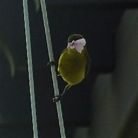
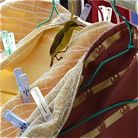
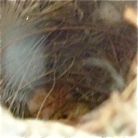
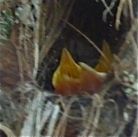
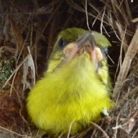
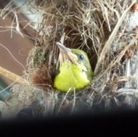
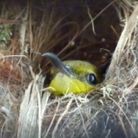
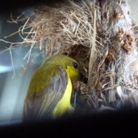







4 Responses
Sunbirds seem to be doing really well here these days.
Really loved the first chick fledge video… Just as it hops off, the camera focuses on its eyes. Pretty!
thanks for sharing these videos. They are really precious 🙂